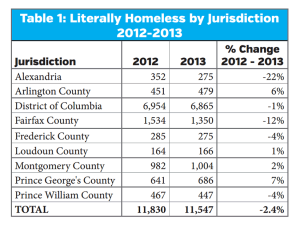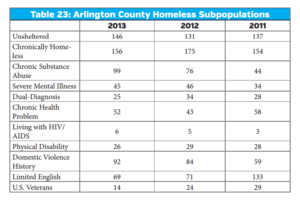 (Updated at 3:50 p.m.) The number of homeless individuals in Arlington County increased 6 percent between 2012 and 2013, but the homeless population is still lower than it was in 2010, according to a newly-released study.
(Updated at 3:50 p.m.) The number of homeless individuals in Arlington County increased 6 percent between 2012 and 2013, but the homeless population is still lower than it was in 2010, according to a newly-released study.
The annual Metropolitan Washington Council of Governments homelessness report revealed that the homeless count in Arlington increased from 451 in 2012 to 479 in 2013. During that same period, the Washington region saw a 2.4 percent decrease in its homeless population, led by a 22 percent drop in Alexandria, a 12 percent drop in Fairfax County, and a 1 percent drop in the District of Columbia.
 Arlington’s homeless population had decreased the past two years, from a peak of 531 homeless individuals in 2010. This year, Arlington has the second highest homelessness ratio — 2.2 homeless persons per 1,000 residents — of any local jurisdiction except D.C., where there are 10.9 homeless persons per 1,000 residents.
Arlington’s homeless population had decreased the past two years, from a peak of 531 homeless individuals in 2010. This year, Arlington has the second highest homelessness ratio — 2.2 homeless persons per 1,000 residents — of any local jurisdiction except D.C., where there are 10.9 homeless persons per 1,000 residents.
Arlington’s latest homeless count was performed on January 30, 2013.
The rise in the local homeless population is happening despite Arlington’s 10 Year Plan to End Homelessness, which was first published in 2006. That plan includes supportive services and rental assistance for homeless individuals, and the opening of the new homeless shelter and services center in Courthouse.
Other vital statistics about Arlington’s homeless population from the MWCOG study include:
- Arlington has 70 homeless families, comprised of 88 adults and 123 kids
- There are 14 homeless veterans in Arlington, down from 24 in 2012
- There were 198 homeless individuals placed in permanent housing in fiscal year 2012
- There were 49 disabled homeless individuals placed in permanent supportive housing in fiscal year 2012
- The number of “chronically homeless” individuals is down from 175 in 2012 to 156 in 2013
- The numbers of homeless individuals classified with chronic substance abuse problems and severe mental illness are 99 and 45, respectively
“The great news is in the County’s success with chronically homeless individuals, where we went from 175 to 156,” said Arlington Dept. of Human Services spokesman Kurt Larrick, in an email sent Thursday afternoon. “These are the people living on the street who are at risk of dying if they don’t get help. This is the target population for our 100 Homes initiative, and we are really pleased with the results to date of getting these Arlingtonians off the street and into stable housing.”
“The Point-in-Time is one lens for looking at the state of homelessness and it gives us some good information,” Larrick continued. “We have other lenses that provide more depth and breadth. What they are showing us is that moving people quickly into housing and providing necessary supports is what results in the best outcomes. Programs like Permanent Supportive Housing and Homelessness Prevention and Rapid Re-Housing use this strategy. And that will be a key strategy at the new Homeless Services Center when it opens in late 2014. With its year-round beds and on-site services, the new center will greatly enhance our ability to get people on the path to stable housing.”

